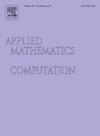Mutual and total mutual visibility in hypercube-like graphs
IF 3.4
2区 数学
Q1 MATHEMATICS, APPLIED
引用次数: 0
Abstract
Let G be a graph and . Then, vertices x and y of G are X-visible if there exists a shortest -path where no internal vertices belong to X. The set X is a mutual-visibility set of G if every two vertices of X are X-visible, while X is a total mutual-visibility set if any two vertices from are X-visible. The cardinality of a largest mutual-visibility set (resp. total mutual-visibility set) is the mutual-visibility number (resp. total mutual-visibility number) (resp. ) of G. It is known that computing is an NP-complete problem, as well as . In this paper, we study the (total) mutual-visibility in hypercube-like networks (namely, hypercubes, Fibonacci cubes, cube-connected cycles, and butterflies). Concerning computing , we provide approximation algorithms for hypercubes, Fibonacci cubes and cube-connected cycles, while we give an exact formula for butterflies. Concerning computing (in the literature, already studied in hypercubes), whereas we obtain exact formulae for both cube-connected cycles and butterflies.
超立方体图中的互可见性和全互可见性
设G为图,X⊥V(G)。那么,如果存在一条最短的x,y路径且不存在内部顶点属于x,则G的顶点x和y是x可见的。如果x的每两个顶点都是x可见,则集合x是G的互可见集,如果V(G)中的任意两个顶点都是x可见集,则x是总互可见集。最大互可见性集的基数。总互可见性集)是互可见性数(例如:总互可视性数μ(G)μt(G))是一个np完全问题,μt(G)也是一个np完全问题。在本文中,我们研究了超立方体网络(即超立方体、斐波那契立方体、立方体连接环和蝴蝶)中的(总)互可见性。关于μ(G)的计算,我们给出了超立方体、斐波那契立方体和立方连通循环的近似算法,同时给出了蝴蝶的精确计算公式。关于μt(G)的计算(在文献中,已经在超立方体中研究过),而我们得到了立方体连接循环和蝴蝶的精确公式。
本文章由计算机程序翻译,如有差异,请以英文原文为准。
求助全文
约1分钟内获得全文
求助全文
来源期刊
CiteScore
7.90
自引率
10.00%
发文量
755
审稿时长
36 days
期刊介绍:
Applied Mathematics and Computation addresses work at the interface between applied mathematics, numerical computation, and applications of systems – oriented ideas to the physical, biological, social, and behavioral sciences, and emphasizes papers of a computational nature focusing on new algorithms, their analysis and numerical results.
In addition to presenting research papers, Applied Mathematics and Computation publishes review articles and single–topics issues.

 求助内容:
求助内容: 应助结果提醒方式:
应助结果提醒方式:


